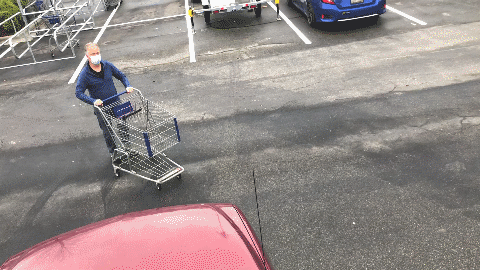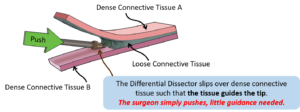A “natural tissue plane” is an important concept in surgery. It is regarded as a plane that can be separated safely because it is usually avascular (has no blood vessels in it) and aneural (similarly, no nerves). A surgeon can thus follow a natural tissue plane with less concern for accidentally damaging critical anatomy.
A natural tissue plane is typically formed by two layers of dense connective tissue separated by a layer of loose connective tissue. The layer of loose connective tissue can be thick, such as subcutaneous fat, or it can be fleetingly thin, like submucosa of the bowel.
Here is where the Differential Dissector shines. As an analogy, consider returning your shopping cart to the cart return at the end of shopping. The cart won’t burst through the rails on the cart return, so you simply push it in, letting it bounce left and right as the cart proceeds to the back of the return. You don’t have to steer the cart.


The Differential Dissector separates a natural tissue plane in similar fashion. You introduce it into the plane and simply push. Really. In fact, the Differential Dissector helps you find the correct plane – it resists forward progress until the DD Tip is in the right plane! As Dr. Chan Park says, “The Differential Dissector … helps you find the plane that you need to be in.”
Once in the plane, the DD tip slides along the layers of dense connective tissue, disrupting the loose connective tissue. The tip won’t penetrate the dense connective tissues, so, like the grocery cart, the DD tip self guides, and the surgeon simply pushes the tip forward.
We have performed numerous dissections in preclinical labs with our eyes closed. (We don’t recommend this for surgery!!) If you encounter a perforating blood vessel or nerve (a blood vessel or nerve that crosses the natural tissue plane), no worry. You just bump into it. The Differential Dissector resists moving forward because the blood vessel wall is made of dense connective tissue. The surgeon senses this as a sharp increase in resistance and then works around it, safely exposing the perforator and allowing the surgeon to choose to spare it or take it.
